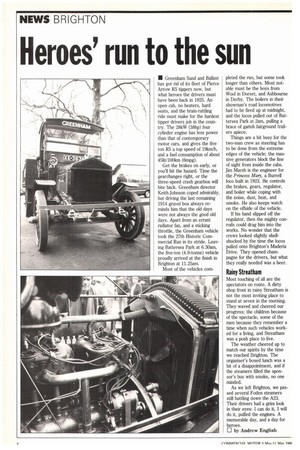eroes' run to the sun
Page 10

If you've noticed an error in this article please click here to report it so we can fix it.
• Greenhorn Sand and Ballast has got rid of its fleet of Pierce Arrow R5 tippers now, but what heroes the drivers must have been back in 1925. An open cab, no heaters, hard seats, and the brain-rattling ride must make for the hardest tipper drivers job in the country. The 28kW (38hp) four cylinder engine has less power than that of contemporary motor cars, and gives the five ton R5 a top speed of 19km/h, and a fuel consumption of about 451it/100km (6mpg).
Get the brakes on early, or you'll hit the hazard. Time the gearchanges right, or the three-speed crash gearbox will bite back. Greenhorn director Keith Johnson coped admirably, but driving the last remaining 1914 gravel box always reminds him that the old days were not always the good old days. Apart from an errant radiator fan, and a sticking throttle, the Greenhorn vehicle took the 27th Historic Commercial Run in its stride. Leaving Battersea Park at 6.30am, the five-ton (4.9-tonne) vehicle proudly arrived at the finish in Brighton at 11.25am.
Most of the vehicles com pleted the run, but some took longer than others. Most notable must be the boys from Wool in Dorset, and Ashbourne in Derby. The boilers in their showman's road locomotives had to be fired up at midnight, and the locos pulled out of Battersea Park at 2am, pulling a brace of garish fairground trailers apiece.
Things are a bit busy for the two-man crew as steering has to be done from the extreme edges of the vehicle; the massive generators block the line of sight from inside the cabs. Jim Marsh is the engineer for the Princess Maty, a Burrell loco built in 1923. He controls the brakes, gears, regulator, and boiler while coping with the noise, dust, heat, and smoke. He also keeps watch on the offside of the vehicle.
If his hand slipped off the regulator, then the mighty conrods could drag him into the works. No wonder that the crews looked slightly shellshocked by the time the locos pulled onto Brighton's Maderia Drive. They opened champagne for the drivers, but what they really needed was a beer.
Rainy Streatham
Most touching of all are the spectators on route. A dirty shop front in rainy Streatham is not the most inviting place to stand at seven in the morning. They waved and cheered our progress; the children because of the spectacle, some of the men because they remember a time when such vehicles worked for a living, and Streatham was a posh place to live.
The weather cheered up to match our spirits by the time we reached Brighton. The organiser's boxed lunch was a bit of a disappointment, and if the steamers filled the sponsor's bus with smoke, no one minded.
As we left Brighton, we passed several Foden steamers still battling down the A23. Their drivers had a grim look in their eyes: I can do it, I will do it, puffed the engines. A memorable day, and a day for heroes.
by Andrew English




































































































